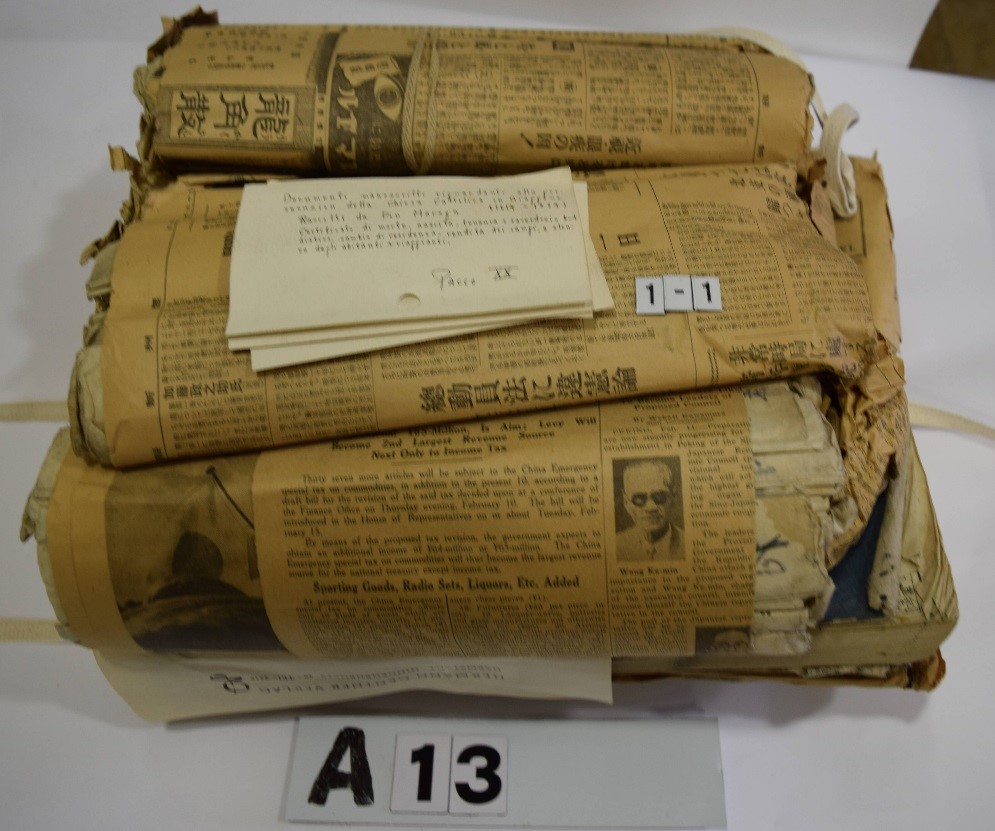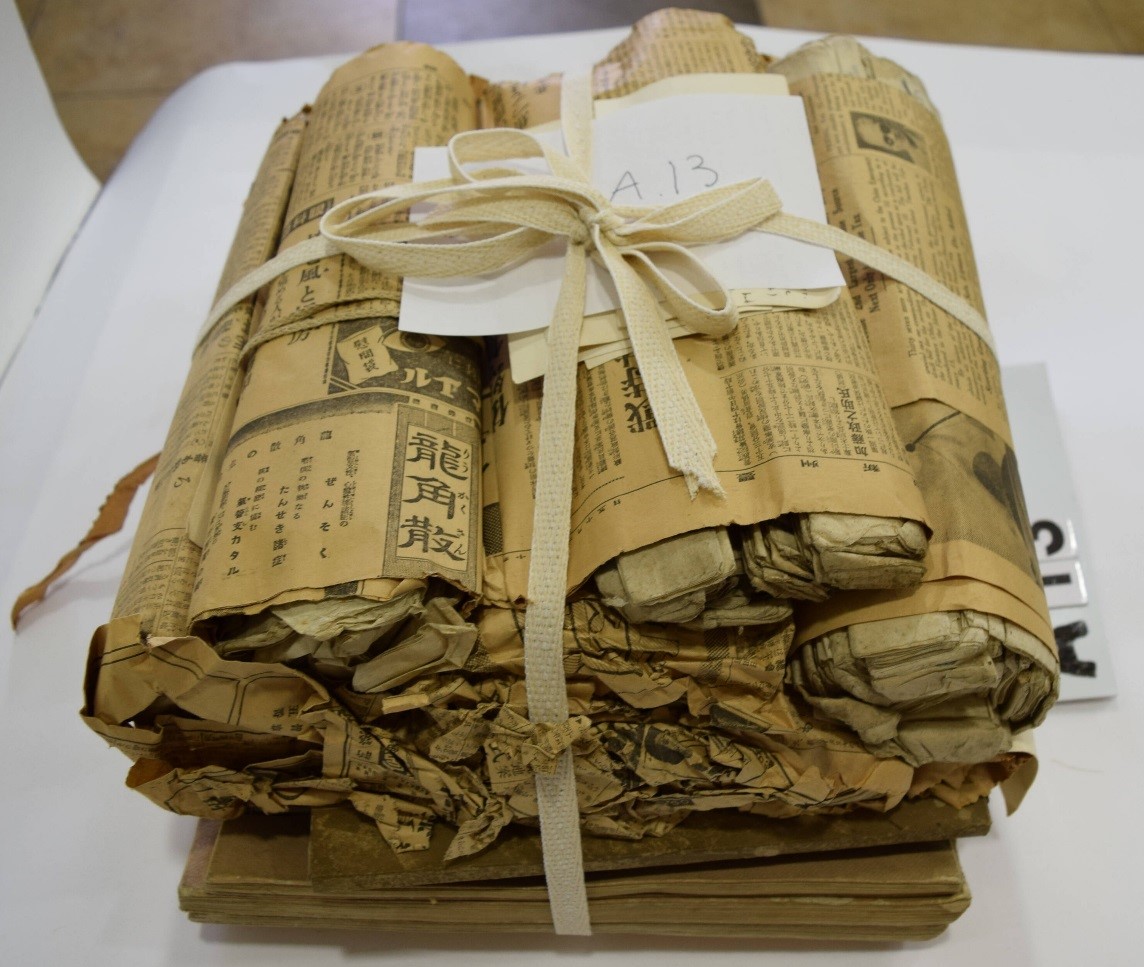- Reference Code
maregaA13
- Title
Fonds Marega File A13
- Date Range
- 1688–1942
- Primary Date Range
- Early 18th century to first half of 19th century. However, there are some items from the 17th century and late 19th century.
- Date Range Notes
- 1688 (Jōkyō 5) – 1942 (Shōwa 17)
- Description Level
File
- Quantity
- 635 catalogue entries, 638 items
- Details
- 513 archival document catalogue entries (499 jō 状 catalogue entries / 499 items, 13 tatechō 竪帳 catalogue entries / 13 items, 1 small yokochō 横帳 catalogue entry / 1 item), 4 book catalogue entries / 7 items, 5 bills / money envelopes, 6 slips of paper, 1 card, 9 pieces of paper for wrapping / newspapers, 2 envelopes, 12 hōshi 包紙, 35 strings (strings, koyori 紙縒, strips of paper), 10 Marega memos (cards), 37 Marega memos (slips of paper), 1 Marega article
- Notes on Physical State
- Before surveying, this file was in a special oxygen-free plastic bag used by the Vatican Library to kill bacteria. There were some archival documents, etc. divided up by newspapers (Hōshū Shimpō 02/03/1938, 07/13/1940; Ōsaka Mainichi / Tōkyō Nichi Nichi English Edition 02/12/1938; Oita Shimbun 07/14/1940, Asahi Shimbun 01/12/1940, NOON EXTRA shanghai 12/24/1942, etc.), envelopes, etc., as well as uncategorized groups of woodblock print books and archival documents grouped together with cotton preservation tape. There were four cards providing an overview of the documents’ content. I was unable to find Marega Numbers. As part of the 2013–2016 general survey preservation measures were carried out. Currently the documents are in acid-free paper envelopes that have been placed in a special container.
- Provenance / Creation
- Father Mario Marega. The archival documents are originally from Usuki Domain's Office of Religious Affairs (shūmonkata 宗門方).
- Place Name
- Ōita City and Usuki City, Ōita Prefecture; Himon’ya, Meguro City, Tōkyō–to
- Positions, etc
- Salesians of Don Bosco Missionary. Archival documents are originally from Usuki Domain Office of Religious Affairs (religion magistrates / shūmon bugyō 宗門奉行).
- Archival History
- Donated to the Vatican Library by Mario Marega in 1953.
- Acquisition Source
- Same as fonds.
- Scope and Content
A13 is comprised of subfiles (1 to 25). In A13.1 there is a card that was under a string that held together the whole file.The A13.2–5, 7–9 subfiles have jō 状 wrapped in multiple newspapers. The bills, etc. in A13.10 and the diary and fragments in A13.11 were also wrapped in newspaper. The content of the remaining subfiles is as follows.
A13.6 Marega article; A13.12–13 Tenpō Bukan 武鑑 (shogunate personnel directory) vol. 1 & 3; A13.14 menu notes (1792 / Kansei 4 and later); A13.15 Bukan vol. 2; A13.16–18 Yoshioka Sannai 吉岡三内 Onoku 御奥 memos, 5 year accounting book for Onoku expenses, Junken gubu ninzu kakitsuke巡見供奉人数書付; A13.19–22 woodblock print books; A13.23–24 records of events, Japanese archery, etc. (copy); A13.25 Public and private notes (kōshi no tomegaki 公私之留書 1824 / Bunsei 7).
In this way, A13 is comprised of a diverse set of materials. Judging from the presence of notes by Marega and the use of newspapers to wrap the subfiles, it is highly likely that Marega created the subfiles.
Subfiles A13.2–5, 7–9 are multiple jō wrapped in newspapers and the like. A13.2 is documents related to the Office of Religious Affairs (A13.2.1.5) and Togami 戸上 family documents related to land sales from 1692 (Genroku 5) to 1880 (Meiji 13). Togami family members served as Oheya 御部屋 foot soldiers (ashigaru 足軽), shogunate gun corps (omochi zutsu gumi 御持筒組), and Ōgumi 大組 rank samurai. During the Tenpō period (1830–1843), Togami Kiheita 幾平太 served as the assistant to the Office of Religious Affairs. The relationship between the Togami family documents and the Office of Religious Affairs is not clear. However, considering that the presence of later documents (1880 / Meiji 13, etc.), it is highly likely that these Togami family documents were mixed in at a later point and did not come from the Office of Religious Affairs. Office of Religious Affairs documents include notifications of people entering and exiting the Usuki Domain, and show us how people moved through the Seto Inland Sea.
A13.3 is comprised of archival documents from 1723 (Kyōhō 8). They include requests to enter the Buddhist order as well as documents for grasping the movement of people. We also find two documents (entitled okakimono no koto 御書物之事) that are corpse inspection certificates for relatives of former Christians. A13.4 is a group of only okakimono no koto from 1701 (Genroku 14). A13.5 and A13.7–8 are groupings primarily of okakimono no koto. However, they are from multiple time periods. A13.9 is okakimono no koto from 1709 (Hōei 6) and 1710 (Hōei 7). Okakimono no koto from 1688 (Jyōkyō 5) are in A13.5.4, and those from 1813 (Bunka 10) in A13.5.5.319 of the archival documents in A13 are okakimono no koto.
The bukan in A13.12–13, 15 are missing their covers, and therefore it is not completely clear whether they were originally part of one set. However, since volumes 1, 2 and 3 (jō 上, chū 中, ge 下) are included, I treated them as such. The kōshi no tomegaki in A13.25 was in an envelope marked “Nikki Okahan” (in the roman alphabet). It is apparently a record from the Usuki Domain; one finds the phrase “Gion-no-su yoriai-jo” 祇園洲寄合所 (Gion-no-su Merchant House).
In this subfile there are also other groups of documents that originally came from a different place. It is highly likely that the documents in A13.11 were purchased at Hareruya Shoten ハレルヤ書店 (Hallelujah Bookstore). A13.11.0.2 has a price tag from this bookstore (¥8). The aforementioned A13.2 is also a group of documents not from the Office of Religious Affairs. There is the possibility that these were not purchased from a seller of used books; they might have been mixed in with documents from the Office of Religious Affairs at a later date.
- Languages Used
- Japanese, 48 Italian catalogue entries, 9 English catalogue entries (newspapers), 1 Japanese (Roman alphabet) catalogue entry
- Date Description Written
- 2017/10/16
- Reference Images

